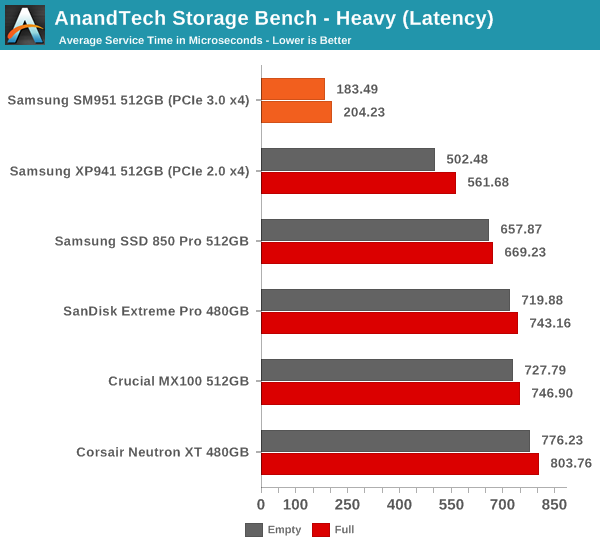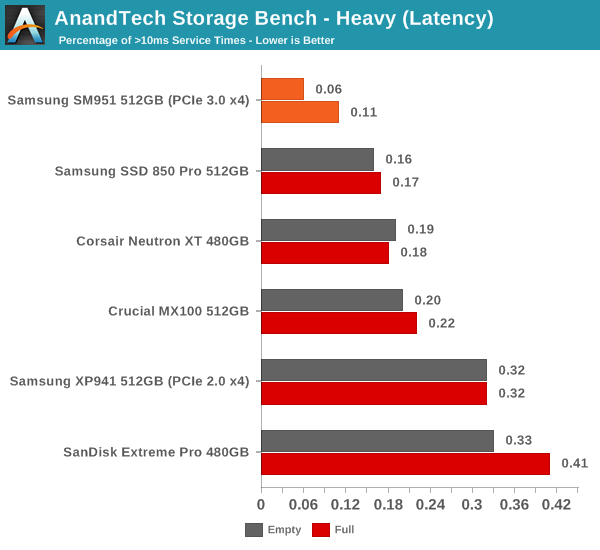Samsung SM951 (512GB) PCIe SSD Review
by Kristian Vättö on February 24, 2015 8:00 AM ESTAnandTech Storage Bench - Heavy
While The Destroyer focuses on sustained and worst-case performance by hammering the drive with nearly 1TB worth of writes, the Heavy trace provides a more typical enthusiast and power user workload. By writing less to the drive, the Heavy trace doesn't drive the SSD into steady-state and thus the trace gives us a good idea of peak performance combined with some basic garbage collection routines.
| AnandTech Storage Bench - Heavy | ||||||||||||
| Workload | Description | Applications Used | ||||||||||
| Photo Editing | Import images, edit, export | Adobe Photoshop | ||||||||||
| Gaming | Pllay games, load levels | Starcraft II, World of Warcraft | ||||||||||
| Content Creation | HTML editing | Dreamweaver | ||||||||||
| General Productivity | Browse the web, manage local email, document creation, application install, virus/malware scan | Chrome, IE10, Outlook, Windows 8, AxCrypt, uTorrent, AdAware | ||||||||||
| Application Development | Compile Chromium | Visual Studio 2008 | ||||||||||
The Heavy trace drops virtualization from the equation and goes a bit lighter on photo editing and gaming, making it more relevant to the majority of end-users.
| AnandTech Storage Bench - Heavy - Specs | ||||||||||||
| Reads | 2.17 million | |||||||||||
| Writes | 1.78 million | |||||||||||
| Total IO Operations | 3.99 million | |||||||||||
| Total GB Read | 48.63 GB | |||||||||||
| Total GB Written | 106.32 GB | |||||||||||
| Average Queue Depth | ~4.6 | |||||||||||
| Focus | Peak IO, basic GC routines | |||||||||||
The Heavy trace is actually more write-centric than The Destroyer is. A part of that is explained by the lack of virtualization because operating systems tend to be read-intensive, be that a local or virtual system. The total number of IOs is less than 10% of The Destroyer's IOs, so the Heavy trace is much easier for the drive and doesn't even overwrite the drive once.
| AnandTech Storage Bench - Heavy - IO Breakdown | |||||||||||
| IO Size | <4KB | 4KB | 8KB | 16KB | 32KB | 64KB | 128KB | ||||
| % of Total | 7.8% | 29.2% | 3.5% | 10.3% | 10.8% | 4.1% | 21.7% | ||||
The Heavy trace has more focus on 16KB and 32KB IO sizes, but more than half of the IOs are still either 4KB or 128KB. About 43% of the IOs are sequential with the rest being slightly more full random than pseudo-random.
| AnandTech Storage Bench - Heavy - QD Breakdown | ||||||||||||
| Queue Depth | 1 | 2 | 3 | 4-5 | 6-10 | 11-20 | 21-32 | >32 | ||||
| % of Total | 63.5% | 10.4% | 5.1% | 5.0% | 6.4% | 6.0% | 3.2% | 0.3% | ||||
In terms of queue depths the Heavy trace is even more focused on very low queue depths with three fourths happening at queue depth of one or two.
I'm reporting the same performance metrics as in The Destroyer benchmark, but I'm running the drive in both empty and full states. Some manufacturers tend to focus intensively on peak performance on an empty drive, but in reality the drive will always contain some data. Testing the drive in full state gives us valuable information whether the drive loses performance once it's filled with data.

The SM951 performs even strongly in our Heavy trace and presents nearly 100% improvement in data rate over the XP941. In full state the SM951 loses a bit of its performance, but that's normal and the drop isn't any bigger than in other drives. Despite the lack of NVMe, it's starting to be clear that the SM951 is significantly faster than its predecessor and any SATA 6Gbps SSD.

The average latency is also cut in less than half, which is actually a more substantial improvement than going from a SATA 6Gbps drive to the XP941.

The share of high latency IOs is also the lowest with only 0.06% of the IOs having a higher than 10ms service time.










128 Comments
View All Comments
Kristian Vättö - Sunday, March 1, 2015 - link
The 840 EVO issue takes weeks, even months to show up, so testing it is not something that we can really incorporate in our test suite.The read speed depends on the test you use and its specifications. The figures are always "up to" and tend to be based on high queue depth 128KB sequential read performance. You may want to try multiple benchmarking apps, but especially ATTO tends to show high performance since it tests multiple IO sizes.
And yes, we run the SSD as a secondary drive to eliminate any OS overhead.
MFinn3333 - Saturday, February 28, 2015 - link
Is there any way you can review the Fujitsu FSX 240GB? It's an old drive but it is the only consumer level drive that I am aware of that uses entirely SLC?Kristian Vättö - Sunday, March 1, 2015 - link
At least for now it's not in the review queue, but I will keep it in mind in case I have excess time.kenshinco - Monday, March 2, 2015 - link
How can we get the sm951 to runs up to the rated speed? The rated speed for 512gb is 2.15gbs/1550mbs read/write, but i got only 1560mbs/1570mbs read/write. I got temp monitor never pass 75 when testing.Kristian Vättö - Monday, March 2, 2015 - link
I was able to achieve 2250MB/s with 128KB sequential read (QD32) on an empty drive, which is how the read performance has been rated. That's not a realistic bench, though, because in reality you will never be reading from an empty drive.Gonemad - Thursday, March 5, 2015 - link
No word on Novachips 8TB SSD yet?http://www.theregister.co.uk/2015/03/05/eight_tera...
CallsignVega - Friday, March 6, 2015 - link
I just purchased the SM951 from the UK (512GB for $450). They are out there, you just have to know where to look.vegipiniata - Wednesday, March 11, 2015 - link
I got one SM951 512GB for 340£They were gone later that day.
Have Z97 Extreme9 and can't set it as the boot drive though :(
Bios 1.3 from DEC 2014
any chance it's the BIOS fault (too old)?
Stas - Friday, March 13, 2015 - link
There we go. Finally an incentive to upgrade from 2500k to a new platform. Once mobos with M.2 and NVM hit the market in Summer/Fall, I will be retiring the faithful rig.Edgar_in_Indy - Friday, March 13, 2015 - link
The 2500k is too good to retire!When I upgraded my main system a few weeks ago, I recycled my old 2500k and the board for use in a living room HTPC build that can handle 4K video files and do some gaming, all while running Windows Media Center with 5 ATSC tuners.